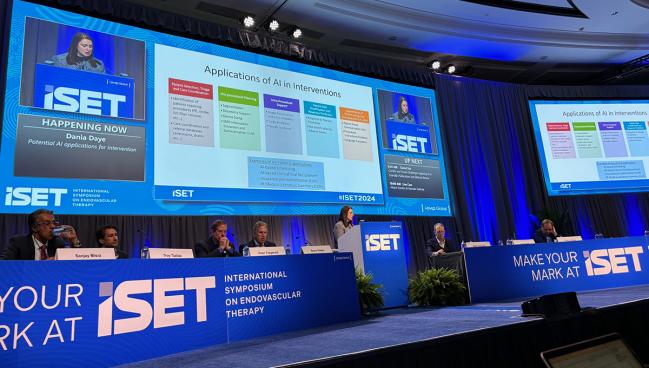AI Tools to Meet Every Need? The Future of Vascular Medicine
Already products are entering the market, and if found to improve outcomes, they may become standard of care.

MIAMI BEACH, FL—Artificial intelligence (AI) is poised to forever change healthcare, but exactly how that revolution will play out in vascular medicine, with diverse disease states and a multitude of treatment options, is a story that’s still being told.
At last week’s ISET 2024 meeting, participants in a Town Hall session offered their perspectives on what the future holds.
As of October 2023, the US Food and Drug Administration has cleared 692 AI-enabled medical devices, said Dania Daye, MD, PhD (Massachusetts General Hospital and Harvard University, Boston), a radiologist who directs her institution’s Precision Interventional and Medical Imaging (PIMI) Lab. Most—but not all—are in the area of radiology.
“While the number of approved algorithms has increased exponentially . . . only one vascular application makes it into the top 10, intracranial large-vessel occlusion, and that’s primarily because this is one of the few applications that actually does have a reimbursement code,” she told ISET attendees in a presentation that looked into the scope of AI. “Based on the trends that I am showing here, there is still a lot of work to be done to break AI into [vascular] interventions and get more FDA-cleared algorithms.”
Cardiac measurements also fell within the top 10, with other algorithms for calcified plaques and cardiac flow following closely behind.
“When I think about AI indications in interventions,” said Daye, “I personally like to think about five different buckets.” These are:
- Patient selection, triage, and care coordination
- Preprocedural planning
- Intraprocedural support
- Patient risk stratification and response prediction
- Augmentation of patient-facing care
“AI is not new. AI has existed for tens of years. It’s just now becoming the hot topic,” Daye commented to TCTMD. For radiologists, who tend to be early adopters of new technologies, especially on the diagnostic side, she said AI is going to become a modality akin to MRI or CT “that we’re going to have to learn how to use.”
Excitement about AI’s potential is starting to spread to other medical specialties, she noted. One area likely to garner broad interest includes tools for “summarizing and pulling out relevant information from the medical record.” These details could be useful not just for doctors, but also for nurses and other healthcare professionals, something that will “really make patient care continuity a lot better, for better patient outcomes. I think this is where the exciting new developments are going to be,” Daye predicted.
Importantly, use of AI-based products won’t be restricted to big-name hospitals and may have much to offer community hospitals and private practices, which have already shown interest in this technology. “I come from an academic medical center where we have a lot of expertise. We have a lot of sub-subspecialty expertise,” she said. “AI is one way that we can extend that expertise beyond [our institution].” This may help to bridge the often-seen rural/urban divide in care or to increase efficiency for smaller hospitals that are stretched thin.
AI isn’t there to replace the clinicians themselves. But if the tools work, the clinicians who don’t use them may be left behind, Daye suggested: “I have to be honest: I am very patient-centered. If there is something that improves patient outcomes, I think this should be the standard of care.”
If there is something that improves patient outcomes, I think this should be the standard of care. Dania Daye
During the ISET session, Daye highlighted several products already on the market in vascular medicine. In that first bucket, there are tools for AI-based detection and communication of acute vascular findings that signal pulmonary embolism, aortic aneurysm, dissection, and deep vein thrombosis. “That’s really streamlining the referral process for us as proceduralists,” she noted.
“The second area where we’ve seen some applications on the market today is patient referral and follow-up databases for subacute vascular findings,” said Daye. “These algorithms usually will use natural-language processing to look through every single [patient] report for clinically actionable aneurysms, for example,” then identify who requires ongoing follow-up. Some platforms can generate an automated email for specialists to send primary care physicians encouraging them to refer particular patients.
In the category of preprocedural planning, she gave the example of AI-based vascular segmentation for use in automated endograft sizing.
Intraprocedural planning consists of things like AI for lesion targeting. However, these tools still mainly are in the realm of research labs, not practice, Daye said. “This is probably one of the hardest areas to do innovation.”
Her PIMI Lab team has ventured into the bucket of risk stratification as well—by using CT-derived metrics of body composition to predict outcomes of patients with liver disease who are receiving transjugular intrahepatic portosystemic shunts, for instance. Specific to the ISET audience, another project Daye and colleagues have pursued is machine learning for prediction of amputation risk in patients undergoing endovascular interventions for PAD.
Patients, too, can engage directly with AI tools: Daye pointed to a paper published recently in npj | Digital Medicine that charts potential uses of large language models in healthcare. “For patients, chatbots are definitely a big area,” she said, pointing to uses in symptom assessment and translation of lab results and physician notes.
For clinicians, too, AI can tackle nonclinical applications that relate to tasks like scheduling, clinical trial recruitment, and even insurance preauthorization letters. “I’m sure many of us would welcome this [last one],” Daye said. Generative AI also presents the possibility of compiling literature reviews, she noted, but it’s important to be alert to the possibility of “hallucinations,” wherein ChatGPT and similar tools produce fantasies as if they are fact.
She concluded: “There is no doubt that incorporating AI and large language models is going to change how we practice in the next 10 to 20 years.” It’s clear, added Daye, that “physicians who use AI will be replacing physicians who do not use AI.”
What’s needed now are prospective multi-institutional trials, rather than small, retrospective studies, so that more algorithms are available, she said.
Troy Tazbaz, director of the FDA’s Digital Health Center of Excellence (Washington, DC), in the same session, summed up the ways the agency has been preparing to address this new reality. To start, they released a proposed framework for regulating AI- and machine learning-based software in 2019. More recently, the FDA issued formal guidance on clinical-decision support software in 2022 and has draft guidance in the works addressing how manufacturers can best revise these products over time.
Caitlin E. Cox is News Editor of TCTMD and Associate Director, Editorial Content at the Cardiovascular Research Foundation. She produces the…
Read Full BioSources
Daye D. Applications of artificial intelligence in interventions: current state and future directions. Presented at: ISET 2024. January 23, 2024. Miami Beach, FL.
Tazbaz T. Challenges & opportunities in assessing medical AI products: shaping standards and safeguarding AI development and integration in healthcare delivery. Presented at: ISET 2024. January 23, 2024. Miami Beach, FL.
Disclosures
- Daye reports serving as a consultant to Medtronic, Sigilon Therapeutics, and Boston Scientific; being on the speakers bureaus of Medtronic and Boston Scientific; serving on the advisory board of TriSalus; and receiving grant funding from TriSalus.
- Tazbaz reports no relevant conflicts of interest.





Comments